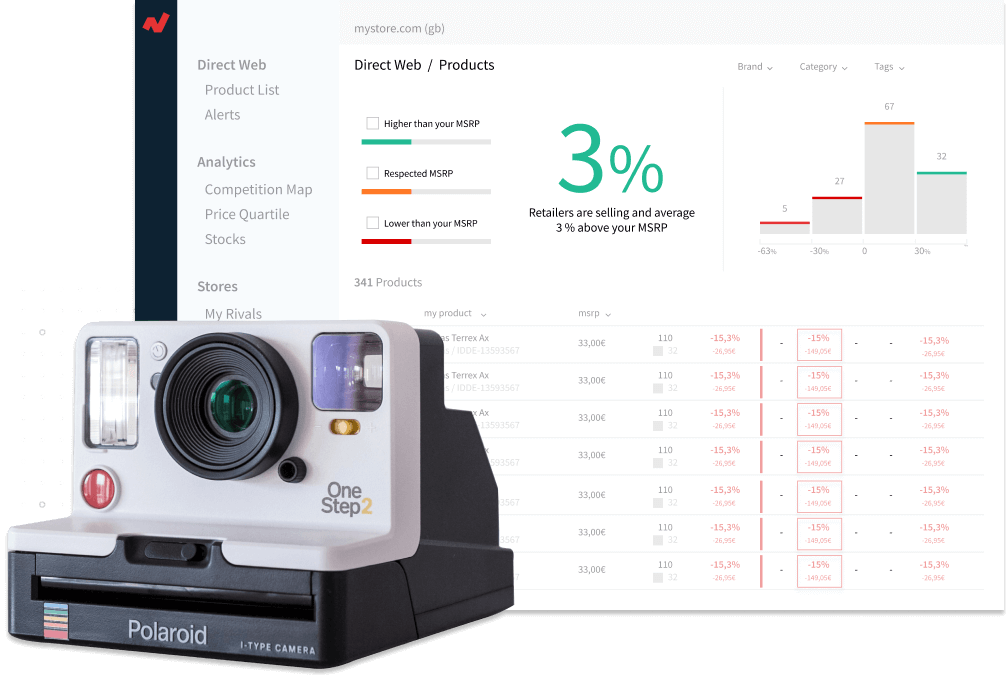Carrying out a competitor analysis that works properly and generates the expected results requires an in-depth study of the main factors that impact on the performance, revenue and image of any online store: competition, markets, sector and product offerings.
The evolution and constant changes in the ecommerce world are a reality and, according to recent studies, it is estimated that the online retail industry will reach an approximate value of 4.9 billion dollars by 2021. So any retailer who is considering the growth of their online business and wants to maximize their revenues and conversions for the future, can not ignore the importance of the competitive analysis we mentioned earlier.
Determine the positioning of your online store through sector analysis
Before getting started with business competitor analysis, it is necessary to establish in a clear and detailed way what the characteristics of the sector are and to see how the specific ecommerce business fits into it.
There are certain points that should be considered at this point in the analysis:
- The target audience or customer profile: It is essential to have a profile of the customer who will purchase the items and know what they are looking for and expect from their purchase, as well as the attention and experience they want to receive from the online store. Of course, this profile will not be completely definitive at the beginning of the analysis and will be something that can be developed in more detail in the future. In fact, there is also the possibility of finding secondary profiles of target customers.
- Determining product range: To what field does the store belong? Will it specialize in a single vertical or in several of them within the same sector? It is interesting to have this clear from the beginning and over time weigh whether you want to continue adding verticals, depending on the situation.
- Type of product, catalog coverage: the analysis of the product is very relevant, as it will define whether it is a business with an offer of specialised products or of a more general type within the vertical in question.
- Differential elements: How do you want to achieve differentiation? It is very important to be clear on which points will make the difference between the online store in question and its competitors. Will it be a purely competitive strategy or will additional tactics be developed to attract the target audience?
Business competitor analysis as a fundamental strategic element
Analyzing the competition is a fundamental aspect and on which any good ecommerce strategy is based. There are certain steps that cannot be omitted at this stage.
- The use of platforms such as Google Shopping and Amazon to quickly detect major competitors in the sector. It will be easy to establish which stores in the search results can be considered direct competitors, as they will share a business model and catalog similar to your online store.
- Of all the rivals you’ve encountered, you’ll have to divide between those who have a strategy similar to yours or the one you’d like to develop, and those who are industry leaders and have a different strategy.
- With this first list, you can create a spreadsheet that includes competitor information regarding names, websites, strengths and weaknesses, social media, appearance on platforms such as Shopping and Amazon, customer reviews, etc.
With all this information, the next step would be to classify the analysed rivals in one of the following two areas:
Direct competitors
These are stores that target the same type of customer as the online store in question and have the same types of items in their catalog.
Indirect competitors
These are stores that offer a similar type of product, but in its low or high price version. The latter may cause the type of audience to be sensibly different.
Price as a decisive factor in the purchasing process
To the previous elements that must be analyzed we must add one that is decisive in the purchase process for any user: the price.
Price is a central factor in competitive analysis and can be used as a lever to improve the competitive advantage of any online store and increase store conversions.
It could be said that 60% of users who buy online base their purchasing decisions on price. This is why it is so important to monitor the activity of rival stores to detect changes and patterns in their pricing. This type of price control has a very positive impact on the ability of any online store to react to price fluctuations and allows them to adapt to the state of the market and competition. Similarly, this price tracking can be used as a lever to improve conversion results in platforms such as Shopping, while helping to optimize the perception of competitiveness that potential customers have on a specific online store.
Detect opportunities and threats through market analysis
Daily monitoring of the positioning of the most direct competitors provides relevant data about the state of the market, as well as the opportunities and risks arising from their strategic changes. For this reason, it is worth having certain critical aspects under control:
- Competitive price history: have rival stores made recurring price changes at specific times? Is there a recurring downward price trend? Answering these and other questions can help detect patterns and anticipate rivals’ movements.
- Stock status: the stock status can be used as a lever for maximizing conversions and widening margins. Consumers have a certain sense of urgency, so they will always shop in those stores that can deliver more immediately the product they want to buy.
- Positioning or PI against rivals: it is extremely important to know if you are aligned with the competition. If not, conversion opportunities could be lost.
- Minimum margins: profit margins should never be put at risk. When making price changes, the minimum margins for specific products or ranges should always be taken into account.
Develop and reinforce your ecommerce strategy through ecommerce pricing engines
As can be extracted from all of the above, competitive analysis is an indispensable tool in the strategy of any online retail business, as this study will lay the foundations to make business decisions. Such decisions and strategy changes will have a great impact on the performance and profitability of the online store, especially in terms of pricing.
In this sense, nowadays there are great solutions in the form of software to track prices online that help to automatically capture and manage data related to shipping costs, price changes, opinions, positioning and competitiveness level. All this in order to speed up decision-making and act in a relevant way to optimize the results of the strategy that has been put into practice.
In conclusion, remember that in such a changing and competitive environment it is best to have complete and updated data on the market in order to carry out the necessary strategic actions.




